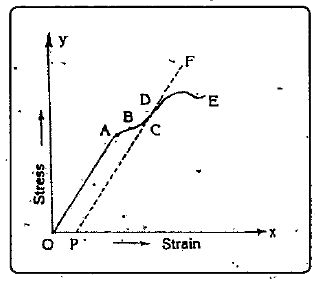Describe the behaviour of a wire under gradually increasing load.
Behaviour of a wire under increasing load:
.Let a wire is suspended at one end and loads are attached to the other end. When loads are gradually increased the following changes are noticed
1) Proportionality limit (OA):
When load is increased the elongation of the wire gradually increases. The maximum load upto which the elongation is directly proportional to the load is called proportionality limit (A). The graph drawn between load and extension is a straight line. So point A is called: proportionality limit. In this region. Hooke.s Law is obeyed.
2) Elastic limit (B):
If the load is increased above the proportionality limit the elongation is not proportional to the load. Hooke.s law is not obeyed. But it exhibits elasticity which means that it regains the original length if load is removed. The maximum load on the wire upto which it exhibits elasticity is called elastic limit (B in the graph).

3) Permanent set (C):
If the load on the wire is increased beyond elastic limit say. upto .C., the elongation is not proportional to load. On removal of the load the wire does not regain its original length. Length of wire increases permanently. In figure permanent set is given by OP: So OP is called permanent set.
4) Point of ultimate tensile strength (D) :
If the load is further increased, upto .D. then strain increases rapidly even though there is no increase in stress.
At this stage the restoring forces seems to be subdued to then deforming forces. Elongation without increase in load is called creeping. This behaviour of metal is called yielding.
Fracture point (D):
If the load is increased beyond Yield point the elongation is very rapid, even for small changes in load the wire becomes thinner and breaks: This is shown as E. The breaking force per unit area is called breaking/stress.
Topper's Solved these Questions
- MODEL PAPER 10BOOK - VGS PUBLICATION-BRILLIANTCHAPTER - MODEL PAPER 10EXERCISE - Section - C
3 Videos
- MODEL PAPER 10BOOK - VGS PUBLICATION-BRILLIANTCHAPTER - MODEL PAPER 10EXERCISE - Section - C
3 Videos
- MODEL PAPER 1BOOK - VGS PUBLICATION-BRILLIANTCHAPTER - MODEL PAPER 1EXERCISE - SECTION - C
3 Videos
- MODEL PAPER 11BOOK - VGS PUBLICATION-BRILLIANTCHAPTER - MODEL PAPER 11EXERCISE - Section - C
3 Videos
Similar Questions
Knowledge Check
The molar heat capacity at constant pressure of nitrogen gas at STP is nearly 3.5R. Now when the temperature is increased, it gradually increases and approaches 4.5R. The most approprite reason for this behaviour is that at high temperatures
Anitrogen does not behave as an ideal gasBnitrogen molecules dissociate in atomsCthe molecules collides more frequentlyDmolecules vibration gradually beome effective
Discuss the behaviour of wire under increasing load .
View SolutionState Hooke's law and describe with the help of a diagram, the behaviour of a copper wire which hangs vertically and is loaded with a gradually increasing load until it finally breaks. On the diagram mark the points (i) elastic limit (ii) yield point.
View SolutionThe molar heat copacity of oxygen gas at STP is nearly 2.5R. As the temperature is increased, it gradually increase and approaches 3.5R. The most appropriate reason for this behaviour is that at high temperatures
View SolutionThe molar heat capacity at constant pressure of nitrogen gas at STP is nearly 3.5R. Now when the temperature is increased, it gradually increases and approaches 4.5R. The most approprite reason for this behaviour is that at high temperatures
View SolutionThe molar heat capacity of oxygen gas at STP is nearly 2.5R. As the temperature is increased, it gradually increase and approaches 3.5R. The most appropriate reason for this behaviour is that at high temperatures
View SolutionThe molar heat capacity of oxygen gas at STP is nearly 2.5R. As the temperature is increased, it gradually increase and approaches 3.5R. The most appropriate reason for this behaviour is that at high temperatures
View SolutionThe increase of length of a wire under a load is equal to its initial length. What is the stress in the wire equal to?
View Solution
